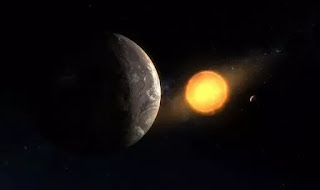ANOTHER EARTH: NASA discovers planet which has striking similarities to Earth
NASA has discovered a distant planet which it believes is remarkably similar to Earth as the hunt for alien life steps up a notch.
Data from NASA's Kepler telescope, which was retired in 2018 yet more data keeps rolling in, has revealed an "Earth-like" exoplanet which could support the conditions for life.
The planet has been named Kepler-1649c and is located more than 300 light years away.
Yet despite its staggering distance from Earth, with one light year being around 5.88 trillion miles, NASA has deduced that it is the "most similar to Earth in size and estimated temperature" that Kepler has spotted.
The planet is roughly the same size as ours, albeit slightly larger, but receives just 75 percent of light levels that Earth does.
Thomas Zurbuchen, associate administrator of NASA’s Science Mission Directorate in Washington, said:
"This intriguing, distant world gives us even greater hope that a second Earth lies among the stars, waiting to be found.
“The data gathered by missions like Kepler and our Transiting Exoplanet Survey Satellite (TESS) will continue to yield amazing discoveries as the science community refines its abilities to look for promising planets year after year."
However, it might be a bit premature for us to begin packing our suitcase as there are still many unknowns about the planet.
Kepler-1649c orbits a red dwarf star, which are known for releasing deadly amounts of solar radiation in the form of huge flares.
NASA said: "This newly revealed world is only 1.06 times larger than our own planet.
"Also, the amount of starlight it receives from its host star is 75 percent of the amount of light Earth receives from our Sun – meaning the exoplanet's temperature may be similar to our planet’s, as well.
"But unlike Earth, it orbits a red dwarf. Though none have been observed in this system, this type of star is known for stellar flare-ups that may make a planet's environment challenging for any potential life."
Little is also known about what the atmosphere consists of, with further tests needed to determine whether it is capable of homing life.
However, what is known is that it is in the Goldilocks Zone - a region around a star where it is neither too hot, nor too cold for life to exist.
NASA was also able to determine that a year on the planet is equivalent to just 19.5 Earth days.
Andrew Vanderburg, a researcher at the University of Texas at Austin, said: "Out of all the mislabeled planets we've recovered, this one's particularly exciting – not just because it's in the habitable zone and Earth-size, but because of how it might interact with this neighbouring planet.
"If we hadn't looked over the algorithm's work by hand, we would have missed it."
"The more data we get, the more signs we see pointing to the notion that potentially habitable and Earth-size exoplanets are common around these kinds of stars.
"With red dwarfs almost everywhere around our galaxy, and these small, potentially habitable and rocky planets around them, the chance one of them isn't too different than our Earth looks a bit brighter."












No comments: